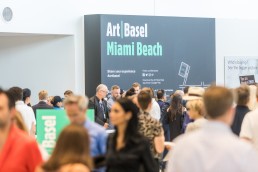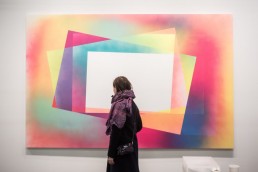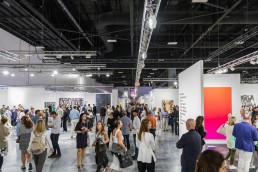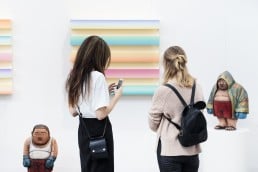Art Fairs, A Global Phenomenon
The Rise of the Art Gathering
By Peter Letzelter-Smith
At the most utilitarian level, art fairs are simply trade shows. The trade is art. And like trade shows in any industry, they’re gatherings that bring sellers and potential buyers together in one place to converse, negotiate, and do deals. On a more inspirational level, art fairs are opportunities to feel the excitement of sharing time and space with other lovers of art. To see and to be seen. To get introduced to new galleries and new artists and to be stimulated. They are, at their best, broad avenues of inspiration for you to stroll down.

Today art fairs play a critical role in the world of contemporary art, accounting for millions of dollars of revenue for galleries and a must-do part of the calendar for a wide variety of collectors, curators, agents, and artists. They are amazing opportunities to not only see art, but talk and learn about the art of collecting in any number of ways, including wandering through a myriad of temporary gallery spaces, attending symposiums, and catching featured performances.
Art fairs are not new. The first one is widely considered to have been the Salon des Refusés in Paris in 1863. It was a show featuring the work of contemporary artists who had been rejected by the Salon of the French Academy, whose curators preferred “the canon” of classical and Renaissance art. It was an antiauthoritarian statement that was also about producing income for antiauthoritarian artists.

Another important historic art fair was the International Exhibition of Modern Art, better known as the 1913 Armory Show. Held in New York and featuring many American artists, it’s best remembered for introducing European artists like Vincent Van Gogh, Paul Gauguin, Pablo Picasso, Paul Cézanne, Henri Matisse, and Marcel Duchamp to the left side of the Atlantic Ocean. It pushed the envelope in the then artistically conservative United States, especially the abstract works not yet seen by American eyes. It helped create the modern art market in the United States and is the foundation for much of the 20th-century art collections of major U.S. museums.
Since 1970, when the important Art Basel was first held and created the template for the contemporary art fair, the number of and importance of art fairs have steadily increased. This is especially true over the last decade, which has seen a steady proliferation of art fairs. What were once occasional and sporadic events have now become annual gatherings that dominate the world of art collecting.

The heavyweights on the global art fair circuit include Art Basel, Frieze London, Frieze New York, the European Fine Art Fair (TEFAF Maastricht), the Armory Show New York, ARCO Madrid, and Art Dubai. There are now close to 200 significant art fairs held globally each year.
The reasons to attend an art fair are manifold. There is a dizzying array of artworks to be seen — and that’s ultimately what collecting is about, encountering a work that moves you so much that you want it in your presence full-time. But there are also educational seminars, social mixers sponsored by major galleries, and bars full of people with similar interests talking shop and trading leads.

For new collectors, attending a major art fair is like the first year of college. New ideas are found and new relationships discovered. Being around more experienced and savvy collectors will allow someone new to the game the opportunity to observe and learn. The sheer volume of artistic works will present a crash course in observation, discernment, and learning the nuances of the art market.
The fact that art fairs bring galleries from around the world to the same place at the same time is also of great appeal. The sheer commitment of time and money it takes to visit diverse galleries in different locales is daunting, but an art fair reverses that dynamic. The galleries have committed the time and resources to travel to one centralized place. And their staffs are well aware that they are there to answer questions and reach out to potential new clients, so it creates the perfect environment for asking questions and getting some one-on-one time with people who are knowledgeable in the field.

There are now so many art fairs annually that specialized niches have developed. The Frieze Masters fair, which occurs concurrently with Frieze London, specializes in works that are more than 50 years old. In contrast, the majority of the works featured at the New Art Dealers Alliance (NADA) fair in Miami Beach are pieces created in the year prior to the event.
At this point, art fairs are part a global art tourism market that supports a phalanx of not only galleries, but also hotels, restaurants, and local economies.
Sources:
https://www.artspace.com/magazine/art_101/art_market/a_beginners_guide_to_art_fairs1-5958
https://www.art-mine.com/collectorscorner/art-fairs-three-perspectives/
https://www.artsy.net/art-fairs
Get your free copy of Artland Magazine
More than 60 pages interviews with insightful collectors.